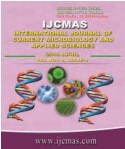


 National Academy of Agricultural Sciences (NAAS)
National Academy of Agricultural Sciences (NAAS)

|
PRINT ISSN : 2319-7692
Online ISSN : 2319-7706 Issues : 12 per year Publisher : Excellent Publishers Email : editorijcmas@gmail.com / submit@ijcmas.com Editor-in-chief: Dr.M.Prakash Index Copernicus ICV 2018: 95.39 NAAS RATING 2020: 5.38 |
Fruit rot or Mahali disease of Arecanut (Areca catechu L.) is a serious threat from countries in those regions which receives heavy rainfall during kharif season specially, malnad, hilly and coastal regions of Karnataka. Arecanut grown in these regions are highly prone to the occurrence of the fruit rot disease resulting in severe loss in yield Therefore, present investigations were carried out during 2015-17, at three different locations viz., Koluru, Manchale and Melige of Shivamogga districts of Karnataka, India. Field trials were conducted under All India Coordinated Research Project (AICRP) on Palms to identify suitable ecofriendly management measures. Among the treatments tested, Bordeaux mixture (BM. 1 %) was found most effective followed by Fenamidone 10 %+Mancozeb 50 % (W/W) (@ 0.3 % spray +Adhesive. However, among the biocontrol agents tested, microbial consortia containing Trichoderma harzianum (IMI304056), Pseudomonas fluoroscens (NCB19046) and Bacillus megatarium (NCTC9848) was found to be most effective in reducing the disease incidence as well as enhancing the development of new roots, increase in number of leaves and yield per palms indicating the merits of using bio agents.
 |
 |
 |
 |
 |